![]()
MENU
BADGES
ORNAMENTATION
Arrowhead Patch
Belt
Buttons
Cap Insignia
![]() Collar Ornaments
Collar Ornaments
Hat
Hatband & Straps
Law Enforcement Insignia
Length-of-Service Insignia
Nametags
Sleeve Brassards
Tie Ornaments & Pins
Miscellaneous
Conclusion
Photofile
Appendix
Bibliography
Notes

BADGES and UNIFORM ORNAMENTATION
of the NATIONAL PARK SERVICE
ORNAMENTATION: Collar Ornaments
|
The first documented collar ornament to be worn on the uniform of a park ranger was the US from the collar insignia of Army officers. This shows up in two portraits of rangers in Sequoia National Park circa 1910 and 1912-16. It was easy to obtain and dressed the uniform up to look official. Although the Secretary of the Interior had authorized the use of a uniform in the parks in 1911, nothing was said about distinctive insignia. Consequently, the various parks were left to their own devices.
|
In 1916, Washington Bartlett "Dusty" Lewis, then supervisor at Yosemite, had Meyer's Military Shop in Washington, D.C., make up several NPS insignia. [49] When Lewis proposed that the National Park Service adopt an ornament for the new 1920 coat, he offered one of these as a possible model. From the correspondence, it would appear that these were simply letters attached to a bar, which could be pinned to the collar. Responding to Lewis, Acting Director Cammerer wrote, "There are a number of serious defects in the design, which is a stock-cut proposition put out in the cheapest possible way for the largest gain." [50] No examples of this ornament have been found, but it shows up in a couple of photographs depicting Yosemite rangers from around 1919. One is of Forrest Townsley, taken while he was on temporary duty at Grand Canyon National Park and the other is of William "Billy" Nelson, from the Ansel Hall Collection. If stock, as Cammerer states, the letters would probably be 1/2". | |||
|
| |||
|
In late 1917 or early 1918, Service headquarters started requiring "N.P.S." to be stitched on the collar of the uniform in bronze thread, "to match the buttons." [51] There is a 1919 forestry green cloth coat in the Yellowstone collection with NPS on the collar. [52] In this case the N.P.S. is embroidered on a piece of coat material and then stitched to the coat collar. The original bronze-colored thread has faded to an orange. This coat would indicate that the NPS was used from it's introduction until the new metal USNPS collar insignia came in with the 1920 regulations. Glacier had earlier requested that G.N.P. be applied to their collars, but this was turned down. The 1920 uniform regulations ushered in what was to become the second oldest insignia still in use by the National Park Service: the USNPS collar ornament. Only the button is older. Building on Lewis's suggestion, the Service finally decided to use the NPS but with US over it. A drawing of the ornament shows that the letters were to be 1/4-inch high and states: "Device to be supplied with strong pin with safety catch, pin to be attached length wise of device. and so fixed to same that pin does not project beyond outer edge of device. Die to become property of Government." Officer's ornaments were to be heavy gold plate. ranger's. No. 12 gauge German silver, and temporary ranger's, bronze (plated brass). The die was retained by the Service and loaned to the successful bidder whenever new ornaments were required. From the appearance of the extant examples of this early pin, the die must have been rather crude in comparison with later ones.
The USNPS collar ornament was a source of much ridicule since few outside the Service understood the significance of the letters. As a result of this, it was decided at the 1926 superintendent's conference to replace it with a new insignia consisting of the Interior Department or National Park Service seal or words superimposed with the letters US. The Landscape Engineering Division was assigned the task of coming up with design recommendations and the field was invited to send ideas to the chief landscape engineer for consideration. [53] The first offering returned by Thomas C. Vint of the Landscape Division was a pencil sketch of a circle with a large US in the center surrounded by DEPARTMENT OF THE INTERIOR/NATIONAL PARK SERVICE. [54] Shortly thereafter, a blue print was forwarded to the Washington office. After examining the blueprint, Acting Director Cammerer returned it suggesting that the US be made smaller, so as not to fill the entire circle. The following months brought forth a number of drawings of suggested collar devices. Unfortunately, none of these have been found with the correspondence. The favorite seems to have been a shield-shaped device. Apparently the draftsman thought that this design had the inside track, as well, for he included it on one of the initial drawing of the 1928 regulation uniform. | ||||
It was decided at the superintendents' conference in 1928 to dispense with the silver and bronze collar devices and to have everyone wear gold ornaments. But no agreement could be reached on the design, so the ornament revision was tabled. In January 1931 it was decided that because of the lack of "inspiration," the Service would keep using the old ornaments until "something really appropriate can be devised." [55] And that is where it stands today. While retaining the same basic design, the ornaments have undergone minor changes over the years. in the late 1930s the fastening device was changed to a screw post like that used by the military. This was changed again in the 1960s to the popular and much more convenient bayonet pin with spring fasteners. In the 1961 handbook, released in November 1959, the colors were changed again. Now only the superintendents and assistant superintendents were to wear gold collar ornaments and everyone else was to wear silver. With the 1971 uniform regulations, gold devices once again became the standard for all uniformed personnel. They remain so today. For a while in the 1980s, plastic collar ornaments were being sent with the uniforms. It was difficult to distinguish these from the metal ornaments, although they would scratch and break if handled roughly. The current ornaments are again of metal. | ||||
Continue

|
Last Modified: Fri, Jan 17 2003 07:08:48 am PDT
http://www.cr.nps.gov/history/online_books/workman1b/volj.htm
![]()

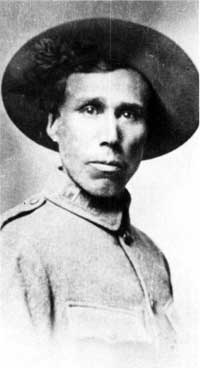


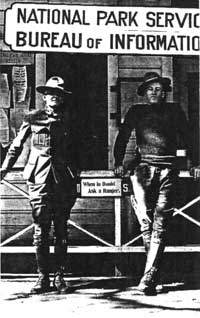

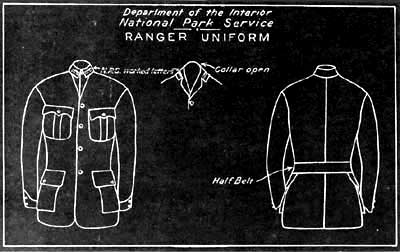
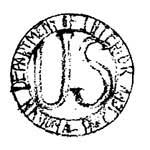
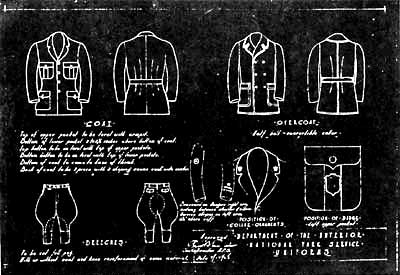
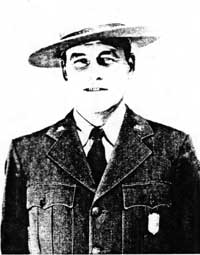
 Top
Top